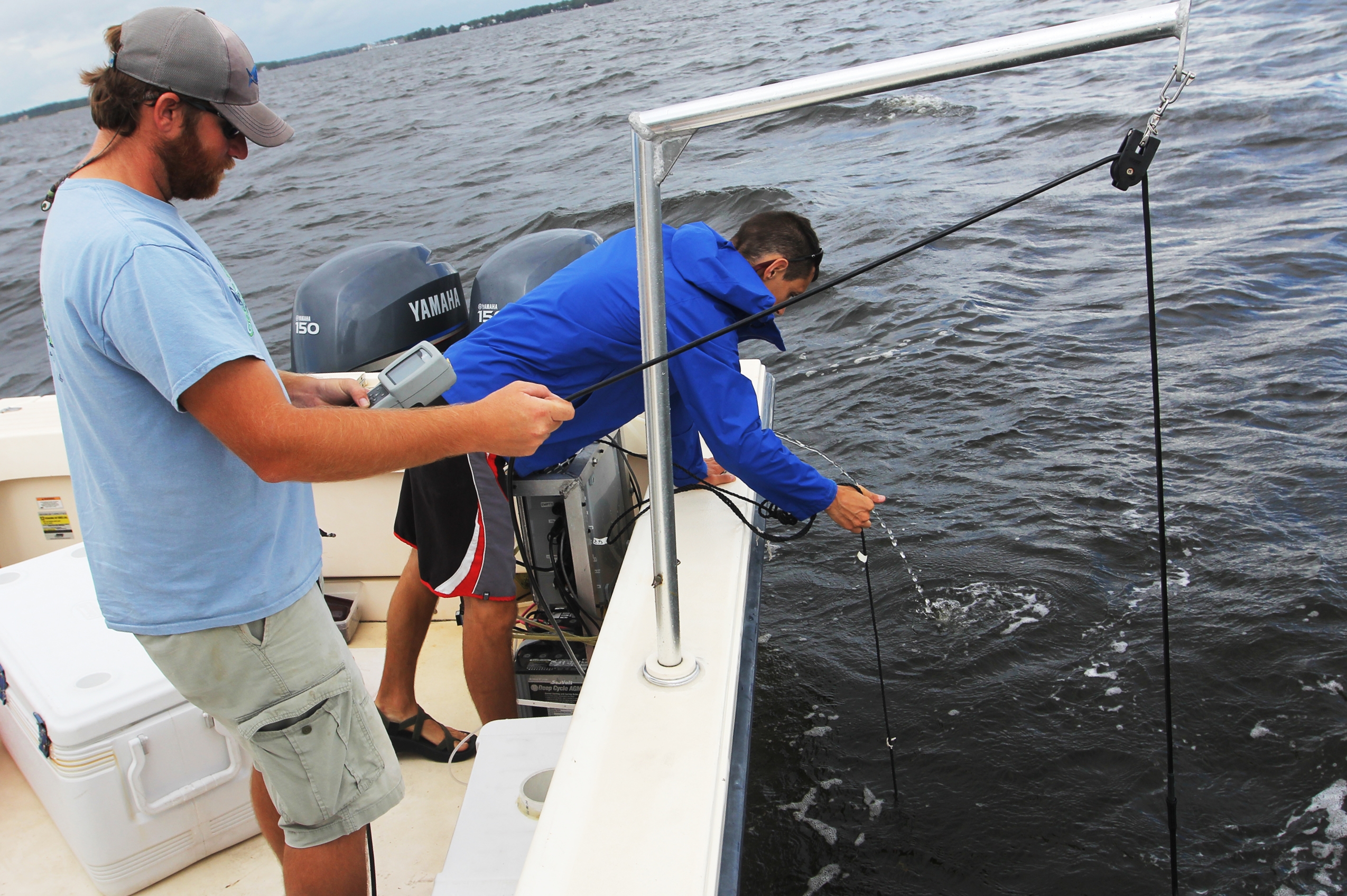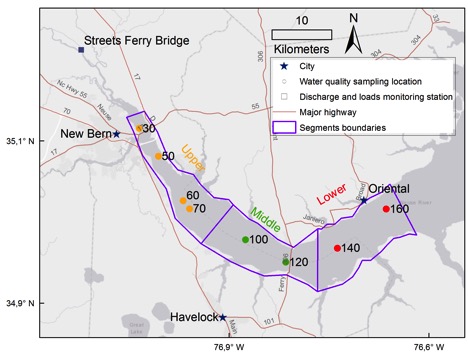Model Forecasts Severe Hypoxia through August in Neuse Estuary
FOR IMMEDIATE RELEASE
Contact:
Daniel Obenour, NC State University, drobenour@ncsu.edu
Katie Mosher, North Carolina Sea Grant communications, 919-515-9069, kmosher@ncsu.edu
An experimental model — developed by a team that includes researchers at North Carolina State University and the University of North Carolina at Chapel Hill — is forecasting levels of low dissolved oxygen this summer that will be worse than those normally in the Neuse River Estuary. The conditions are known as severe hypoxia.

“The model reveals important drivers of water quality in this ecosystem, and allows us to forecast dissolved oxygen levels based on nutrient loads and flows over the preceding nine months,” says Daniel Obenour of NC State, the lead researcher on the project. “Hypoxia can lead to system stresses, including fish kills.”
Through a project funded by North Carolina Sea Grant, Obenour, an environmental engineer, is collaborating with coastal ecologist Hans Paerl of the UNC-CH Institute of Marine Sciences. Obenour also works on models to predict algae blooms in Lake Erie, as well as the extent of the hypoxic zone, known as the dead zone, in the northern Gulf of Mexico.
The new model builds upon decades of data collected by Paerl’s laboratory through the Neuse River Estuary Modeling and Monitoring Project, known as ModMon. That larger project has collected data along the estuarine portion of the river, between New Bern and the Pamlico Sound. The Neuse River’s headwaters, including Falls Lake, are located in the Triangle.
“Stratification, nutrient loading and hot summer weather can cause changes to a river estuary ecosystem. One change is a drop in dissolved oxygen levels,” Obenour explains.
“The estuary serves as an important fisheries habitat. Thus, improving water quality through understanding hypoxia’s triggers is a mission-critical goal for water-resource and fisheries managers, public officials, and others,” he adds. The model and other research results will be shared with these groups.
“We are pleased to see one of the state’s long-term monitoring datasets being used to help manage estuarine systems,” notes John Fear, deputy director for North Carolina’s Sea Grant and Water Resources Research Institute. WRRI has been among the funders for ModMon efforts over the years.
“Without these extensive datasets, a model would not be possible,” Fear adds.

To develop the model, Obenour, Paerl and their team identified biophysical interactions, including the amount of water flowing out of the river into the estuary in different seasons, and the quantity of nutrients that water carries.
The model generates daily predictions of dissolved oxygen in the estuary’s bottom waters, the lowest three feet. While hypoxia can occur from spring through fall, July and August tend to be the most severe months for hypoxia and fish kills. Thus, predictions of July to August 2018 dissolved oxygen were aggregated to create this forecast.
“Water in the estuary resolves itself into two layers, lighter surface water and denser bottom water – like Italian dressing in a bottle separates into lighter and heavier layers,” Obenour explains.
“The surface layer of water contains more oxygen because oxygen-producing algae reside there and it is exposed to the air. The bottom water contains less oxygen because of a few factors. One being no exposure to the air, another being oxygen-consuming microbes,” he adds. “Like the spices at the bottom of the salad dressing bottle, algae and related organic material settle into the bottom water where the microbes feed on it and reduce the water’s oxygen content.”
For their measurements, Obenour and Paerl reviewed data from eight monitoring locations, which overall reflected the upper, middle and lower sections of the estuary.
“The model predicts that average bottom-water dissolved oxygen levels will drop below 2 mg/L — a critical threshold for many aquatic species, indicating a greater likelihood of fish kills,” explains Alexey Katin, an NC State engineering graduate student working with Obenour.
The team pinpointed two main reasons for low bottom-water dissolved oxygen — both related to the rate of water flow into the estuary from upstream, as measured by the U.S. Geological Survey.
First, the new model’s results suggest that a lower river-water flow rate in winter and early spring allows organic matter to build up in the estuary, instead of flushing out as usual. “Think of it as a tub with a clogged drain,” Fear suggests.

Average flow rates from December 2017 to April 2018 were 30 percent lower compared to mean flow rates over the two-decade study period.
Second, because of high levels of precipitation in the spring of 2018, late spring and summer river flows are elevated by about 60 percent, compared to the mean over the past two decades. Higher flows typically carry higher nutrient loads through the estuary, which fuel algal production.
Using the tub example again, this can be like unclogging the drain, thus letting all the previously blocked water and nutrients flow into the estuary.
Obenour and Paerl anticipate another year of testing before their hypoxia forecasting model will be finalized. They stress that it is still experimental, even as it predicts a higher likelihood of severe hypoxia in the Neuse for July and August.
“The experimental forecast developed earlier this year is already beginning to be confirmed in the trend for conditions observed so far in July,” Paerl notes. “The long-term value of the model is that it will help us predict the extent of hypoxia in future years, which will depend on varying winter and spring rains that drive nutrient-laden runoff entering the estuary.”
Obenour is eager to share the results with the public and various resource managers. “We hope to raise people’s awareness and get them thinking about this issue of nutrient loading in the ecosystem,” he says.
Fear agrees: “Managing nutrients is key to decreasing the hypoxia threat.”
For background information, read about the team’s prior research into water quality issues in the Neuse River Estuary, which serves as a foundation for their experimental model. Another blog post takes a deeper dive into modeling and identifying sources of nutrient loading that can lead to algal blooms.
###
North Carolina Sea Grant: Your link to research and resources for a healthier coast
- Categories:


